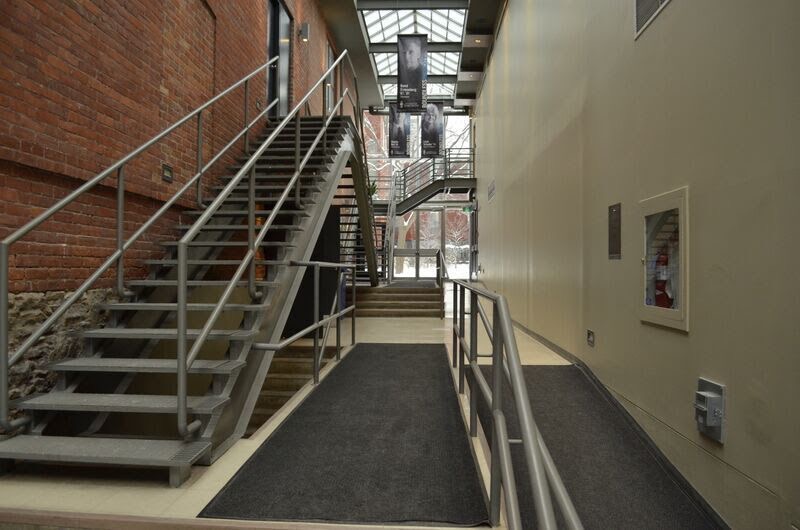Innis Imagined
Plans in motion for the future of the college
Since pushing its fifty-year mark in 2014, plans to improve the College’ s physical space are now in the works. Such improvements include the leveling of the structure currently at 2 Sussex Avenue, or building a multi-story student centre in the residence’ s quad. As Dean Tim Worgan puts it, “dream big people, anything is possible.” Whatever the final plan will be, it’ s certain that the College will undergo significant changes over the next ten years that will involve not only construction, but also years of planning for university and neighbourhood approval.
Innis College outgrew its sparse housing at 2 Sussex Ave. a long time ago. Today, the College struggles to provide space for its academic programs and its own students. The majority of Urban Studies classes now take place in other locations on campus. As Cinema Studies, Writing and Rhetoric, and Urban Studies grow in size, the staff attached to these programs are being pushed out of their own offices. In fact, next year, offices for at least one of Innis’ programs will be housed in an apartment suite on the ground floor of the residence.
However, it is not just academic programs that are suffering in the current spaces the College has to offer. Innis students are also faced with a lack of student space, accessibility issues, and poorly designed social settings. The Commuter Lounge, for example, is small, cramped, and poorly insulated. The library is dingy and desolate, usually accommodating only a few snoring students. Additionally, people are forced to congregate so closely together that tensions arise between students playing noisy games of foosball in the Commuter Lounge and administrators looking for a quiet lunch at the Innis Café. As if crowded, boisterous places weren’ t irritating enough, there is also a horrifying story of a rodent falling out of an air vent in a second-story classroom in the College.

Accessibility issues are another recurring theme in discussions about the failures of the College’ s design. A brief stroll through Innis highlights the impossibility for students with physical disabilities to access almost anything in the old green house that’ s attached to the college, let alone navigate the hallways of the second and third floors.
Despite its failures and awkward spacing, there is something to be said about the current setting of the College. Its red brick walls, distinctive architecture, and fused historical house connect Innis with the Annex’ s mismatched houses and unique businesses, like the handcraft book publisher situated just north of the college on bpNichol Lane. Likewise, Town Hall is a gem within the array of concerns about the College’ s accessibility issues. Yet, none of these characteristics are enough to ignore the problems that Innis’ space is creating for students, staff, and administers alike.
When the inevitable alterations happen, there are certain realities that will have to be taken into consideration. First, the College will not be acquiring more space. The two locations that can be altered and developed, are what we have now: the Sussex building and the residence. Second, since the needs are unilateral, any new spaces will need to accommodate constituents across the board. This means that not only will student space be an aspect of any new design, but so will offices and classrooms. Third, Robarts will soon be creating new student space, and any updates to Innis College will need to avoid redundancy. Finally, there are certain structural and capital features that will restrict any new designs. For example, additions cannot be made to the 2 Sussex Ave. location without replacing the existing building, as the foundations of the current design are not deep enough. However, larger changes to the residence are possible, as the underground parking lot has created strong foundations. Capital will also limit the projects. Although revenue tools such as a levies and private donations are on the table, Innis ultimately does not enjoy the wealth that other colleges do.
All new designs will come down to what current students and staff envision. A series of town hall consultations have taken place over the past month, creating a fairly clear picture of what the different parties are imagining. Amongst the features being considered are a 24-hour study space, segmented floors for varying degrees of noise, more active outdoor living space, and new meeting spaces and offices for clubs. ICSS Commuter Representative Zakerie Farah says he wants to create space so that if a student thinks “‘ I need a place to go’ , then Innis is the first place that comes to mind.” Currently, the only developments have been the installation of an inexpensive student print centre and the expansion of wireless internet connection throughout the residence. But big changes are coming. By the end of the academic year, in typical Innis fashion, a planning board will be in place. It will be made up of a plurality of staff and students that will begin designing serious plans for the updates.

Featured images courtesy of Tristan Fraser
